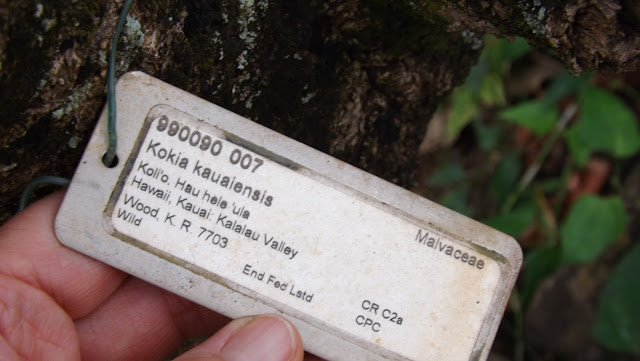Plants, plants, native plantsJune 1, 2013
Native Plant Society at National Tropical Botanical Garden
We didn’t have a huge turnout to weed the native plants
at NTBG but it was fun, good people, very good people. Weeding was interspersed with a very intimate
and private tour of micro sections of the huge garden that lies between Poipu
(public entrance) and Kalaheo (administrative entrance).
We weeded a hillside, slightly steep just up from this
shot. Below us is a section of pili
grass and native palms. The palms
(pritchardia) are each verified as to original location – mostly extremely
remote from high valleys, cliff faces, and uninhabited islands
These pritchardia palms at NTBG are the largest collection of the rare Hawaiian trees
Stayin' alive, stayin' alive
We were working uphill from here, a little steep! Finished working, we walked and drove to sights Mike De
Motta wanted to share. Just for fun I
thought I’d show some of the native hibiscus family. One of the first things newbies about native
plants in Hawaii
I’ve shown others in the past but just for today, these hibiscus caught my eye.
Kokia kauaiensis, first collected in Kalalau Valley
The leaves are beautiful, and the flowers strangely wonderful:
This is the kind of detailed documentation each plant has
Hau (how) is the Hawaiian name for hibiscus,
They were excellent botanists who recognized related plants
The unopened flower bud is almost luminescent
this was the only flower that had opened already, pretty high up in the tree
Hibiscus: St. Johnnyensis
These are very sweet little 2" blossoms, very rich orange
Not as common this St. Johhnyensis is goldenrod
The two plants are near each other at the garden
Back at my car I got some shots of the wiliwili I had parked under – so grateful there are a few left. Some years ago, an unwanted gull-wasp was introduced among imported plants and they have devastated nearly all the wiliwili trees on the islands. Lihue’s harbor was once lined with them, the name Na Wiliwili Harbor, na meaning plural. Even ten years ago, they were city landscaping. They stood along the street all along the Walmart parking lot. No more, but this proud tree stands, so far. Cross your fingers.
Wiliwili tree
Usually pronounced like willy willy, it should really be veely-veely
Wiliwili blossoms up close
Driving on, Mike led us to a new cultural section at the
garden. They have built a hula platform
(mound in front will have grass) and a hale built in the ancient Hawaiian
method. With all of the pritchardia
palms, they have an abundance of leaves for the roof.
Following Mike DeMotta through the garden
Hale (hall-eh) behind the hula mound not yet grassed
Thatched with loulu or pritchardia palm leaves
I look forward to whatever performances they hold here - beautiful location
Mike on left, then Amanda, her Mom and husband Craig, then Kim, and Keren
all major players in Native Plant Society
Kahaleo
After lunch with the plant guys, I met a friend who has
returned to Kauai and is now living in Kalaheo; we went for a walk at Kukuiolono Park Japanese
Garden
While the others speak for themselves, this flat stone was not marked
Marion laid down and said it was like a hot stone massage, warm from the sun
We took turns
In a small space history goes back to the large sugar
plantation culture now giving way to housing developments, before that to the
Hawaiian culture, and before to a time when lava was still freshly pouring new
land that would become Kauai .

What an amazing place we live where we can just walk around and observe such spans of time,
at least this historian is impressed and grateful to be here
A hui ho!



















No comments:
Post a Comment